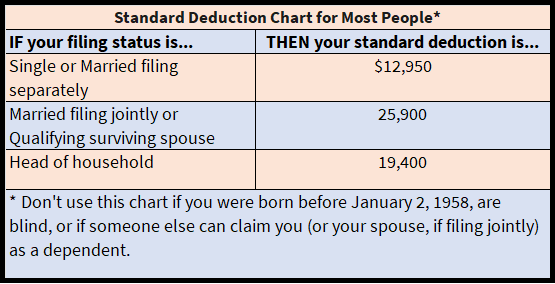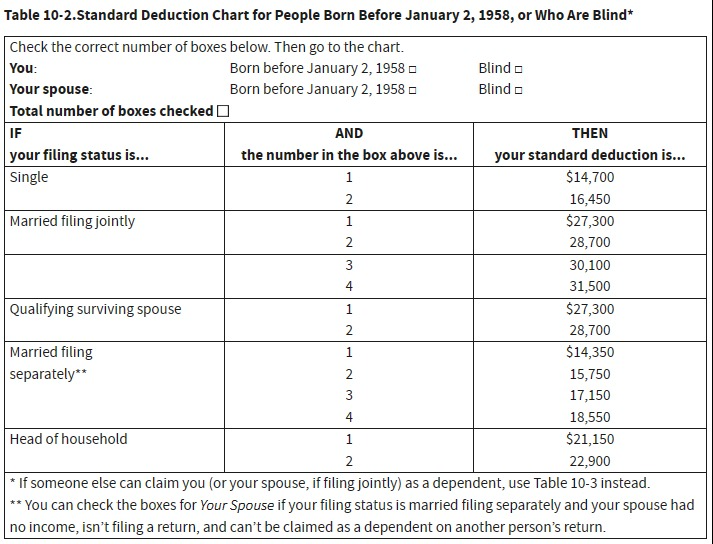I. Introduction
A. Explanation of what the standard deduction is:
The standard deduction is a fixed dollar amount that taxpayers can subtract from their taxable income. It is an alternative to itemizing deductions, where taxpayers would add up all their eligible deductions and subtract them from their taxable income. The standard deduction is meant to simplify the tax filing process and reduce the burden of calculating all the eligible deductions.

B. Brief overview of who can and cannot take the standard deduction:
Most taxpayers can take the standard deduction, but there are some exceptions. Taxpayers who are married filing separately and whose spouse itemizes deductions must also itemize deductions. Additionally, individuals who are claimed as a dependent on someone else’s tax return generally cannot take the standard deduction. Finally, nonresident aliens and dual-status aliens are also not eligible for the standard deduction.
II. How to Determine if You Should Take the Standard Deduction or Itemize
A. Explanation of When to Itemize
When you file your taxes, you have the option to either take the standard deduction or to itemize your deductions. Itemizing means you add up all the qualifying expenses you paid throughout the year, and then deduct that amount from your taxable income. You should itemize if the total amount of your deductions exceeds the standard deduction amount.
B. Factors to Consider When Deciding Between the Standard Deduction and Itemizing
Large Uninsured Medical and Dental Expenses
If you paid a significant amount of medical and dental expenses out-of-pocket and you were not reimbursed by insurance, you may be able to deduct those expenses on your taxes if you itemize. However, there is a limit to how much you can deduct based on your income. In 2022, the threshold for deducting medical expenses is 7.5% of your adjusted gross income (AGI).
Interest and Taxes on Your Home
If you own a home, you may be able to deduct the interest you paid on your mortgage and any property taxes you paid during the year. These deductions can be significant and can push you over the standard deduction threshold.
Large Uninsured Casualty or Theft Losses
If you experienced a casualty or theft loss that was not reimbursed by insurance, you may be able to deduct that loss on your taxes if you itemize. However, the amount you can deduct is limited to the amount that exceeds 10% of your AGI.
Large Contributions to Qualified Charities
If you made significant charitable donations during the year, you may be able to deduct those donations on your taxes if you itemize. The deduction amount is limited to a percentage of your AGI, depending on the type of charity and the type of donation.
Total Itemized Deductions are More Than the Standard Deduction
If the total amount of your itemized deductions exceeds the standard deduction, you should consider itemizing. In 2022, the standard deduction for single filers is $12,950, and for married couples filing jointly, it is $27,800.
In conclusion, deciding whether to take the standard deduction or itemize can be a complex decision. You should consider your individual circumstances and consult a tax professional if you are unsure.
III. 2022 Standard Deduction Tables
A. Explanation of the three tables and when to use each one:
The IRS provides three standard deduction tables for taxpayers to use, depending on their filing status. These tables show the amount of the standard deduction taxpayers can claim on their tax returns, without having to itemize their deductions.
The three tables are:
- Single or Married Filing Separately
- Married Filing Jointly or Qualifying Widow(er)
- Head of Household
Taxpayers should use the table that corresponds to their filing status.

B. Example scenarios for each table:
Single or Married Filing Separately
Taxpayers who are single or married filing separately can use the Single or Married Filing Separately table. For tax year 2022, the standard deduction for this table is $12,950. This means that if your total itemized deductions are less than $12,950, you should take the standard deduction.
For example, let’s say you are a single taxpayer and your total itemized deductions for the year are $10,000. In this case, you should take the standard deduction of $12,950, rather than itemizing.
Married Filing Jointly or Qualifying Widow(er)
Taxpayers who are married filing jointly or qualifying widow(er) can use the Married Filing Jointly or Qualifying Widow(er) table. For tax year 2022, the standard deduction for this table is $25,900. This means that if your total itemized deductions are less than $25,900, you should take the standard deduction.

For example, let’s say you and your spouse are filing jointly and your total itemized deductions for the year are $23,000. In this case, you should take the standard deduction of $25,900, rather than itemizing.
Head of Household
Taxpayers who are filing as head of household can use the Head of Household table. For tax year 2022, the standard deduction for this table is $19,350. This means that if your total itemized deductions are less than $19,350, you should take the standard deduction.
For example, let’s say you are filing as head of household and your total itemized deductions for the year are $18,000. In this case, you should take the standard deduction of $19,350, rather than itemizing.

In summary, taxpayers should use the standard deduction tables provided by the IRS to determine whether they should take the standard deduction or itemize their deductions. If their total itemized deductions are less than the standard deduction for their filing status, they should take the standard deduction.
IV. Electing to itemize for state tax or other purposes.
A. Explanation of when it might make sense to elect to itemize even if your deductions are less than the standard deduction
There are certain situations where it might make sense to elect to itemize your deductions for state tax or other purposes even if your deductions are less than the standard deduction. This is because some states have different standard deduction amounts or do not allow a standard deduction at all. In these cases, electing to itemize deductions could result in a lower state tax liability.
Another reason to elect to itemize could be if you have a significant amount of deductible expenses that are not included in the standard deduction. For example, if you have a large amount of unreimbursed employee expenses or investment expenses, it might make sense to itemize your deductions to take advantage of those deductions.
B. How to make the election
To elect to itemize deductions for state tax or other purposes, you will need to file your state tax return and include a copy of your federal tax return, including Schedule A (Itemized Deductions). You will need to fill out the state tax form that allows you to make the election to itemize, and then provide the details of your itemized deductions.
It’s important to note that electing to itemize for state tax purposes does not change your federal tax return. You will still need to either take the standard deduction or itemize your deductions on your federal tax return, depending on which is more beneficial.
In summary, while taking the standard deduction is generally the easiest option for most taxpayers, there may be situations where itemizing your deductions or electing to itemize for state tax or other purposes could result in lower tax liability. It’s important to carefully consider your options and consult with a tax professional if you’re unsure which option is best for your specific situation.
V. Changing your mind
Sometimes, you might realize that you made an error in your tax return and should have itemized deductions instead of taking the standard deduction, or vice versa. In such cases, you can amend your tax return to correct the error.
A. Explanation of how to change your return if you later realize you should have itemized or shouldn’t have
To change your return, you need to file an amended tax return using Form 1040X. You can only amend your return within three years from the date you filed your original return or within two years of the date you paid the tax, whichever is later. When filling out Form 1040X, you’ll need to include the corrected information and explain the reason for the amendment. You should also attach any forms or schedules that have changed as a result of the amendment.
If you realize that you should have itemized deductions instead of taking the standard deduction, you’ll need to provide all the necessary documentation to support your itemized deductions, such as receipts for charitable contributions, medical expenses, mortgage interest, and property taxes. Make sure to keep copies of all documents you submit with your amended return for your records.
B. Rules for married persons filing separately
If you’re married filing separately and one spouse itemizes deductions, the other spouse must also itemize deductions. In such cases, the standard deduction is not available for either spouse. If you’ve already taken the standard deduction and later realize that you should have itemized deductions, you’ll need to file an amended tax return using Form 1040X.
In conclusion, it’s important to carefully consider whether to take the standard deduction or itemize your deductions when filing your tax return. While the standard deduction is a simple way to reduce your taxable income, itemizing deductions can result in a greater tax benefit if you have significant deductible expenses. If you make an error or change your mind later, you can always file an amended tax return to correct the mistake.
VI. Conclusion
A. Recap of key points:
- The standard deduction is a fixed amount that reduces your taxable income without the need to itemize deductions.
- Taxpayers can choose to take the standard deduction or itemize deductions, but not both.
- Factors to consider when deciding between the standard deduction and itemizing include large uninsured medical and dental expenses, interest and taxes on your home, large uninsured casualty or theft losses, large contributions to qualified charities, and whether your total itemized deductions are more than the standard deduction.
- The IRS provides three standard deduction tables for different filing statuses and ages, and taxpayers should use the appropriate table based on their situation.
- In some cases, it may make sense to elect to itemize even if your deductions are less than the standard deduction, especially for state tax or other purposes.
- Taxpayers can amend their tax return to change from the standard deduction to itemizing or vice versa if they realize they made a mistake, but there are rules for married persons filing separately.
B. Reminder to consult a tax professional if you have any questions or concerns:
As with any tax-related matters, it’s always best to consult with a tax professional if you have any questions or concerns about the standard deduction, itemizing, or other tax issues. Tax laws can be complex, and the advice of a qualified tax professional can help ensure that you are in compliance with all applicable regulations and taking advantage of all the deductions and credits available to you.
